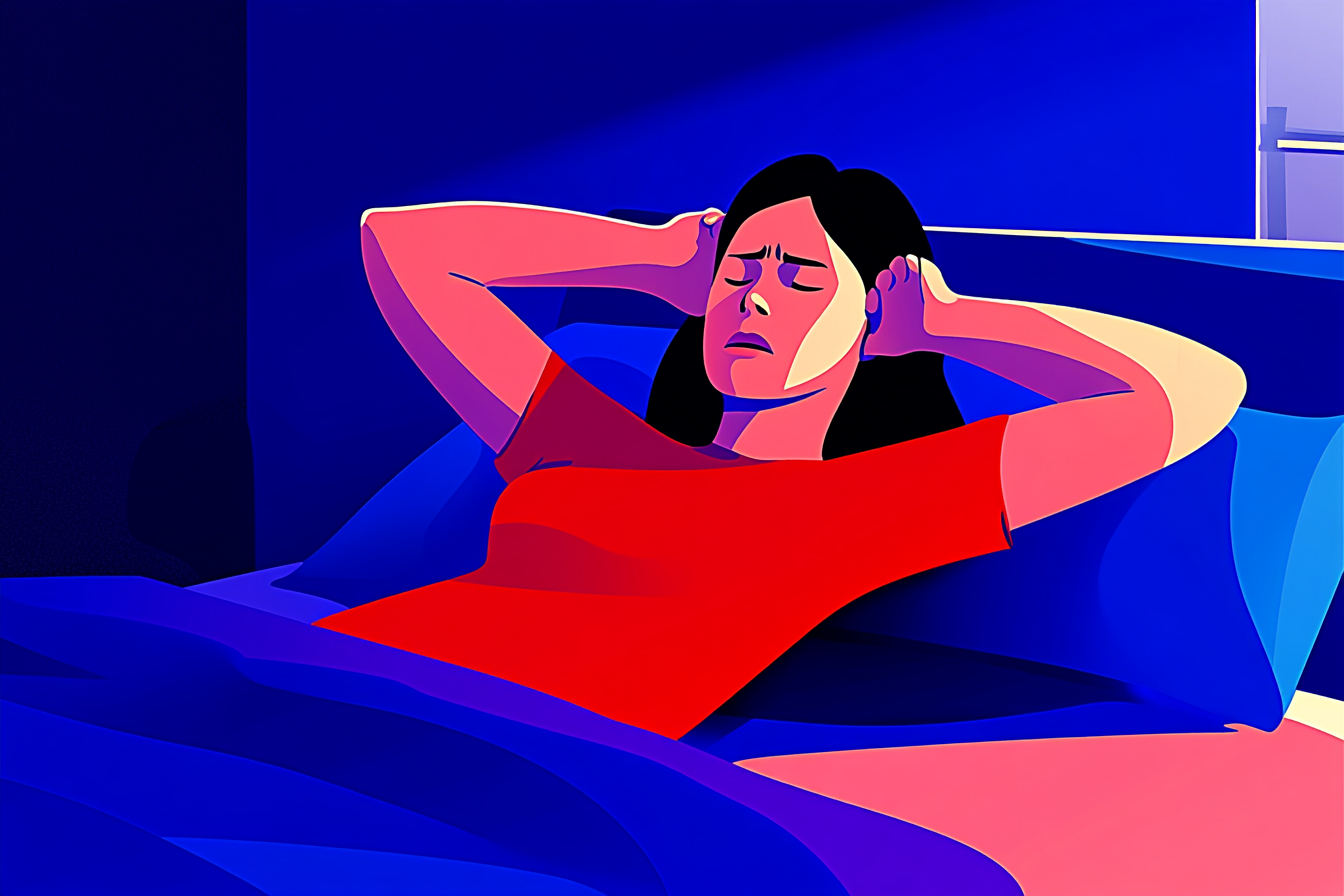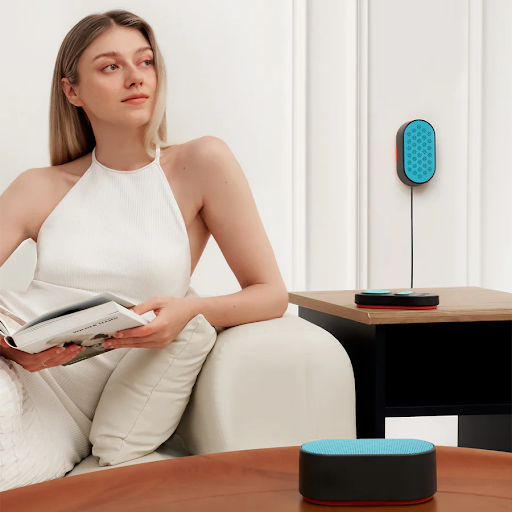Is It Better to Sleep in Silence or With Noise?

Whether you’re a light or a sound sleeper, sudden and loud noises can give you a rude awakening.
You may be one of those people who need to sleep in a silent bedroom. Perhaps you prefer to sleep with noise in the background, or might not even be able to sleep without it.
We’re sure you’re wondering: Is it better to sleep in silence or with noise? That’s what this article aims to explore alongside the advantages and downsides of each.
Key Takeaways
-
Silence helps sleep by reducing stress and anxiety and promoting relaxation. It may also increase awareness of internal body sounds, heighten sensitivity to jarring noises, and cause psychological discomfort, but this varies across individuals.
-
Research studies show that environmental noise significantly disrupts sleep, leading to cardiovascular issues, poor mental health and impaired cognitive function.
-
White, pink, and brown noise can improve sleep by masking environmental noise, with studies showing that they may help some people fall asleep faster and sleep longer.
-
The decision between sleeping with background noise or in a quiet environment depends on personal preference and experimentation.
Table of Contents
Is It Better to Sleep With Noise or in Silence?
We’ll give it to you straight: there’s no cut-and-dried answer. It’s a matter of personal preference. Some benefit from sleeping in a hushed environment, while others get better sleep at night with background noise, especially in areas with high noise pollution.
Does that sound confusing? Let us explain. Certain types of ambient noise can mask disruptive sounds and help you sleep. There are different types of colored noise, including white, pink and brown noise. Nature sounds can also help with sleep.
The best way to determine if sleeping with noise or in complete silence suits you best is to experiment.
Benefits of Sleeping in Silence
As we mentioned earlier, sleeping in a hushed environment has its advantages.
It may enhance sleep quality. Quiet means your shut-eye will be uninterrupted, allowing you to spend more time in the REM sleep and slow-wave sleep stages. The Sleep Foundation says noise can lead to fragmented sleep, reducing the time spent in these stages, which are crucial for achieving restorative and deep sleep.(1) A good night's sleep allows you to take on the day physically, mentally and emotionally.
Sleeping in total silence may also reduce stress and anxiety, which are known to harm sleep quality. It may also calm racing thoughts, making transitioning from wakefulness to sleep easier.
It can promote relaxation, and achieving a relaxed state is essential to a good night's sleep. Research published in the National Library of Medicine found that silence helped lower blood pressure and heart rate more than relaxing music.(2)
A silent sleep environment may also help you manage stress. Noise activates the body’s stress response, triggering the release of the stress hormone cortisol. Chronic noise exposure can put you in a constant state of stress, increasing your risk for anxiety, sleep disruptions and cardiovascular problems.
The Downsides of Sleeping in Silence

Yep, a quiet sleep environment also has its disadvantages.
It can make you more aware of internal sounds, like your heartbeat and breathing. This awareness distracts you from falling asleep and, in some, causes anxiety.
Sleeping in silence can also make you more sensitive to sudden noises. These jarring sounds then become even more unsettling.
Silence might cause psychological discomfort. You may feel isolated with no distraction from racing thoughts. However, this varies across individuals.
Also, those accustomed to a noisy environment may find sleeping in a silent space difficult.
How to Ensure Your Bedroom Is Quiet at Night
Ready to experiment with sleeping in silence? Here are tips to make your bedroom as silent as possible:
-
Soundproof your room: It’s an effective way to block out noise from outside your house or room. Invest in soundproof curtains or acoustic panels to absorb noise. Consider weatherstripping doors and windows to seal gaps where noise filters in.
-
Rearrange your furniture: Place heavy furniture such as bookshelves or dressers against walls facing noisy areas to help block outside noise. Use rugs and carpets to absorb noise.
-
Insulate your interior walls: Consider insulating your interior walls. Insulation won’t completely block out noise, but it may help, especially with sounds from within your house.
-
Use earplugs: This is a no-brainer. Choose quality ones that fit your ears perfectly. Consider earplugs that won’t irritate your ears while providing superior noise blocking.
-
Select your appliances carefully: Pick the silent models for your bedroom.
-
Fight noise with the right kind of noise: If you can’t beat them, join them. Use sleep sound machines, a sleep mask with headphones, or a white noise app to mask disruptive environmental sounds.
The Science Behind Sleeping With Noise
Certain types of noise can improve your sleep by masking the disruptive sounds in your environment. The consistent and soothing nature of these types of noise provides a stable sound environment for uninterrupted sleep.
Beyond sleep, these types of noise — white, pink, brown noise and nature sounds — also promote relaxation and enhance focus. White noise, in particular, has gained popularity as a sleep aid and has become a well-researched topic.
A study published in the National Library of Medicine found that white noise helped participants fall asleep faster and stay asleep longer despite living in a noisy city.(3)
Yet another study from the same source found that white noise improved sleep and eased anxiety and depression levels in patients with schizophrenia.(4)
Sounds That Help You Sleep Better
Now let's take a closer look at the types of noise that help with sleep:
-
White noise is a combination of all frequencies audible to the human ear. White noise has a consistent, unchanging quality that effectively masks disruptive noise. Apart from sound masking, white noise benefits include promoting relaxation and improving focus. White noise examples include TV static or the hum of an air conditioner.
-
Pink noise, also known as flicker noise, has an even power distribution across all audible frequencies. However, its frequency spectrum lowers by 3 decibels with each octave. It’s effective at masking low-frequency sounds, but it's gentler compared to white noise. Examples include gentle wind and rainfall.
-
Brown noise has more energy in its lower frequencies. This noise color has a bass-like tone heard in thunder and waterfalls. It’s great if you’re stressed or anxious, as it promotes relaxation for better sleep.
-
Nature sounds are diverse, meaning there’s something for everyone. Imagine listening to the sounds of ocean waves to help you relax and fall asleep. Nature sounds foster a sense of peace and tranquility.
Sounds to Avoid at Night
Don’t underestimate the power of environmental noise to disrupt your sleep at night, especially transportation sounds like road traffic, aircraft and trains.
Research published in the National Library of Medicine highlights that environmental noise is a major contributor to sleep disturbances. It may result in negative cardiovascular and psychiatric issues for kids and adults. It also harms sleep quality, resulting in daytime sleepiness, impaired cognitive function and low mood.(3)
Other noises to avoid are loud entertainment sounds such as music and TV. Noisy appliances can also disrupt your sleep. Human noises such as loud conversations, sounds from gatherings and your partner's snoring can also disturb your sleep.
All these sounds can unsettle you and trigger your stress response, resulting in high blood pressure and an elevated heart rate, making sleep difficult. Aim to wind down before bed with silent activities like progressive muscle relaxation or reading.
But let’s face it. Sometimes, you don’t have control over your auditory environment. Consider listening to consistent background noise through a white noise machine when silence is impossible.
You’re likely wondering if it’s safe to use a sound machine to fall asleep. The short of it is: Yes.
However, limit your listening time and make sure the noise is not too loud to prevent health risks such as impaired hearing. The ideal volume level for adults is between 50 and 70 decibels. Choose a white noise machine that also allows you to control volume and duration.
Sound variety is also important because white noise doesn’t work for everyone. A selection of background noise to experiment with helps you identify which suits you best.
That said, allow us to introduce Manta White Noise Machine. Here are its key features:
White Noise Machines: A Sleep Game-Changer


-
15 gapless sleep-inducing sounds, including pink, brown, white noise and nature sounds
-
1-click start; no pairing or apps
-
100% LED free (no lights to mess with your sleep quality)
-
Customizable volume and timer settings
-
Tactile control pad allows you to control the device from 32 feet away
-
Upgradeable to a dual-speaker system

We designed this device to help light sleepers get the rest they deserve despite a noisy sleep environment.
This machine acts as a sound barrier, shielding you from disruptive noise before it even reaches you.
Finding What Works Best for You
Determining whether silence or noise will help you sleep better depends on preference. There’s no one-size-fits-all answer. Experimenting is essential.
If you’re accustomed to sleeping with noise, try silence for a week or so to see if it works. Use the tips in this article to achieve the level of silence you need. Tracking your sleep quality during this time will help determine if it works — a sleep journal helps.
If you want to try sleeping with background noise for a change, use a white noise machine. You may also want to try a sleep mask with headphones. Since there are different types of background noise, you’ll also need to identify which ones work for you. White noise might suit you best, but if you find it too harsh, consider pink noise. If neither works, try listening to brown noise or the sounds of nature. A combination may even be ideal.
Conclusion: Finding Your Ideal Sleep Environment
Whether you choose to sleep in silence or with noise, this article will help with that decision.
Each has its own set of pros and cons. Silence during sleep helps your mind and body relax. However, it could also go the opposite way. It may vary across individuals, but silence can become deafening, causing anxiety and psychological discomfort.
Sleeping with background noise might help people fall asleep faster by masking disruptive environmental sounds and sudden noises. However, you’ll need to limit the time spent listening to background noise and keep the volume at a safe level to prevent health risks.
Let us know which one works best for you by commenting below.
Sources:
(1) “How Noise Can Affect Your Sleep Satisfaction.” Sleep Foundation, www.sleepfoundation.org/noise-and-sleep. Accessed 28 April 2025.
(2) “Cardiovascular, cerebrovascular, and respiratory changes induced by different types of music in musicians and non‐musicians: the importance of silence.” National Library of Medicine, pmc.ncbi.nlm.nih.gov/articles/PMC1860846/. Accessed 28 April 2025.
(3) “Environmental noise and sleep disturbances: A threat to health?” National Library of Medicine, pubmed.ncbi.nlm.nih.gov/20562619/. Accessed 30 April 2025.
(4) “Influence of White Sound on Sleep Quality, Anxiety, and Depression in Patients with Schizophrenia.” National Library of Medicine, pmc.ncbi.nlm.nih.gov/articles/PMC11530119/. Accessed 1 May 2025.
Disclaimer: The information contained in this website or provided through our blog, e-mails, or programs is for informational purposes only. It is not intended to be a substitute for medical advice, diagnosis or treatment that can be provided by your healthcare professionals.












































